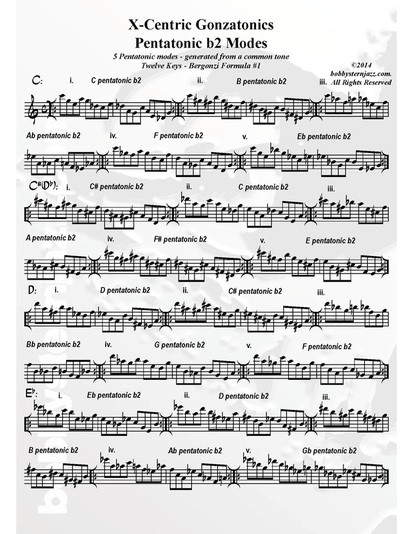
As described in a previous post, which could be well worth checking out, the Pentatonic b2 scale is basically a Major Pentatonic scale with the second degree flatted (C Maj. Penta = C-D-E-G-A to C Penta b2 = C-Db-E-G-A).
Lowering the 2nd degree a half step creates some important new interval relationships; mainly, the interval of a Maj. 3rd (min 6th) between the 2nd & 5th scale degrees (Db (C#) & A), as well as the tritone created between steps 2 & 4 (Db & G).
So, what's it all mean, Mr. Natch'l?
Transpose this (C-Db-E-G-A) 3 times, up (or down) a minor third each time, and you've got yourself all 8 notes of a diminished scale (Eb-E-G-Bb-C, F#-G-Bb-C#-Eb, A-Bb-C#-E-F#).
Actually, you only need to transpose a tritone away to accomplish this, but since the diminished scale divides the octave into 4 equal parts, you've got 4 different Penta b2s, which in many cases, can be subbed for each other.
"We know you're eccentric, but what does "X-Centric" mean? And...what in the name of the Universe is a Gonzatonic!?"
These questions in particular have been perplexing man and womankind for the past 2,000 milliseconds that it took for you to read this.
The enshrouded mysteries of both the "X-Centric" and "Gonzatonic" parts are revealed here, here, here and even here. These posts deal alternately with the Maj. Pentatonic, Pentatonic b3 & b6 scales.
The above Pentatonics (plus b2s) are "X-Centrically" explored even further in "Slicks Licks That Stick! (Vol. 1)" as well as "Gonzatonically" in "Slick Licks That Stick! Vol 2" (without the b2s).
Therefore, presented here is Jerry Bergonzi's "shape #1" formula as presented in his book, "Vol. 2. - Pentatonics" (Advance Music) and applied "X-Centrically" to the 5 modes of the b2 Pentatonic scale.

 RSS Feed
RSS Feed









